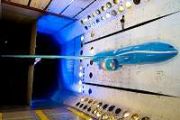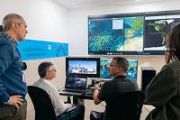
Copernical Team
Close-up views of NASA's DART impact to inform planetary defense
 On Sept. 11, 2022, engineers at a flight control center in Turin, Italy, sent a radio signal into deep space. Its destination was NASA's DART (Double Asteroid Redirection Test) spacecraft flying toward an asteroid more than 5 million miles away.
The message prompted the spacecraft to execute a series of pre-programmed commands that caused a small, shoebox-sized satellite contributed by t
On Sept. 11, 2022, engineers at a flight control center in Turin, Italy, sent a radio signal into deep space. Its destination was NASA's DART (Double Asteroid Redirection Test) spacecraft flying toward an asteroid more than 5 million miles away.
The message prompted the spacecraft to execute a series of pre-programmed commands that caused a small, shoebox-sized satellite contributed by t
Curiosity Captures Mars Landscape While Talking to an Orbiter
 NASA's Curiosity Mars rover demonstrated a new multitasking capability when capturing this view: It snapped the 15 images that make up the mosaic while simultaneously communicating with an orbiter. The images were taken by the right navigation camera on Curiosity's mast July 26, 2025, the 4,611th sol, or day, of the mission. The rover's tracks cross through a region filled with boxwork formation
NASA's Curiosity Mars rover demonstrated a new multitasking capability when capturing this view: It snapped the 15 images that make up the mosaic while simultaneously communicating with an orbiter. The images were taken by the right navigation camera on Curiosity's mast July 26, 2025, the 4,611th sol, or day, of the mission. The rover's tracks cross through a region filled with boxwork formation Rocket Lab marks milestone with 70th Electron launch
 Rocket Lab Corporation has achieved its 70th successful Electron mission, underscoring the rocket's status as the world's most frequently launched small orbital vehicle and reinforcing the company's role as a leader in responsive space launch services.
The mission, called "Live, Laugh, Launch," lifted off from Launch Complex 1 in Mahia, New Zealand on August 23 at 22:42 UTC. The launch occ
Rocket Lab Corporation has achieved its 70th successful Electron mission, underscoring the rocket's status as the world's most frequently launched small orbital vehicle and reinforcing the company's role as a leader in responsive space launch services.
The mission, called "Live, Laugh, Launch," lifted off from Launch Complex 1 in Mahia, New Zealand on August 23 at 22:42 UTC. The launch occ Musk's megarocket faces crucial new test after failures
 Elon Musk's SpaceX is gearing up for the next test of its Starship megarocket on Sunday, after a string of recent failures that has prompted some observers to question its viability.
The world's most powerful launch vehicle is set to lift off from the company's Starbase in southern Texas at 6:30 pm local time (2330 GMT) for its tenth flight.
The mission aims to put the upper stage t
Elon Musk's SpaceX is gearing up for the next test of its Starship megarocket on Sunday, after a string of recent failures that has prompted some observers to question its viability.
The world's most powerful launch vehicle is set to lift off from the company's Starbase in southern Texas at 6:30 pm local time (2330 GMT) for its tenth flight.
The mission aims to put the upper stage t Week in images: 18-22 August 2025

Week in images: 18-22 August 2025
Discover our week through the lens
CerraCap backs Space Kinetic to accelerate space superiority and missile defense
 CerraCap Ventures has invested in Space Kinetic Corp., a cleared national security innovator based in Albuquerque, New Mexico. The move aligns with CerraCap's push to speed space defense technologies and bolster the United States strategic edge as space becomes increasingly contested
CerraCap Ventures has invested in Space Kinetic Corp., a cleared national security innovator based in Albuquerque, New Mexico. The move aligns with CerraCap's push to speed space defense technologies and bolster the United States strategic edge as space becomes increasingly contested BlackSky expands non Earth imaging partnership with HEO under new seven figure contract
 BlackSky Technology Inc. has signed a seven figure Gen 2 space domain awareness expansion contract with HEO to provide fully automated low latency non Earth imaging services for defense, intelligence and commercial missions. The agreement marks the fourth phase of the program, following full automation of the tasking to delivery process.
"BlackSky's high resolution Gen 2 high cadence monit
BlackSky Technology Inc. has signed a seven figure Gen 2 space domain awareness expansion contract with HEO to provide fully automated low latency non Earth imaging services for defense, intelligence and commercial missions. The agreement marks the fourth phase of the program, following full automation of the tasking to delivery process.
"BlackSky's high resolution Gen 2 high cadence monit AI assistant supports Chinese space station astronauts
 The crew of China's Tiangong space station recently conducted their third spacewalk with the help of a new artificial intelligence system named Wukong AI, marking the first use of a large-scale AI model aboard the orbital complex.
Delivered by the Tianzhou 9 cargo craft on July 15, Wukong AI arrived along with upgraded spacesuits, fresh produce, and other supplies. The system, named after
The crew of China's Tiangong space station recently conducted their third spacewalk with the help of a new artificial intelligence system named Wukong AI, marking the first use of a large-scale AI model aboard the orbital complex.
Delivered by the Tianzhou 9 cargo craft on July 15, Wukong AI arrived along with upgraded spacesuits, fresh produce, and other supplies. The system, named after Spacesuit milestone reached with 20 spacewalks on Chinese station
 The extravehicular spacesuit B aboard China's space station has achieved a major milestone by supporting 20 spacewalks, according to the China Astronaut Research and Training Center. Astronaut Chen Dong most recently used the suit on Aug 15 during the Shenzhou XX crew's third series of extravehicular activities.
This accomplishment marks the first time a Chinese spacesuit has met its exten
The extravehicular spacesuit B aboard China's space station has achieved a major milestone by supporting 20 spacewalks, according to the China Astronaut Research and Training Center. Astronaut Chen Dong most recently used the suit on Aug 15 during the Shenzhou XX crew's third series of extravehicular activities.
This accomplishment marks the first time a Chinese spacesuit has met its exten Researchers use electrochemistry to boost nuclear fusion rates
 Using a small bench-top reactor, researchers at the University of British Columbia (UBC) have demonstrated that electrochemically loading a solid metal target with deuterium fuel can boost nuclear fusion rates.
Large-scale magnetic confinement fusion-which puts plasmas under extreme temperatures and pressure-is being widely explored as a method for clean energy generation. The experiment p
Using a small bench-top reactor, researchers at the University of British Columbia (UBC) have demonstrated that electrochemically loading a solid metal target with deuterium fuel can boost nuclear fusion rates.
Large-scale magnetic confinement fusion-which puts plasmas under extreme temperatures and pressure-is being widely explored as a method for clean energy generation. The experiment p 



































